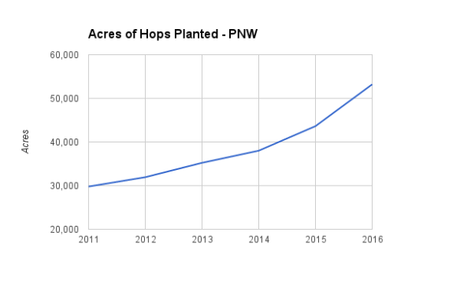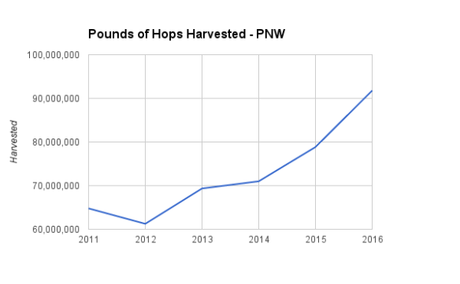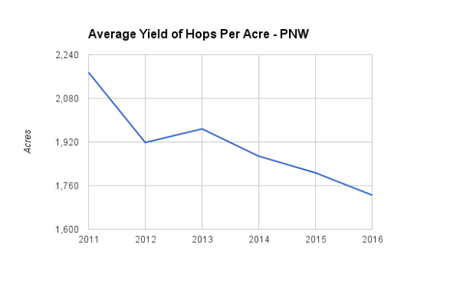
There are many repeated discussions in the beer industry these days.
Beer in cans. IPAs for days. Economic bubbles.
But one aspect that widely gets discussed by beer enthusiasts and the mainstream media with great regularity: hops. Where they're growing, how they're growing and what it means to beer - especially craft - going forward. It's not hard to find reporting on one of the hottest stories in beer, whether we're talking about hops growing in Colorado, Florida or anywhere else.
Even if it means we may be missing one of the most important angles of this often discussed topic.
Everyone's super excited that more acres of hops are being planted. That's why we keep seeing news stories all over reporting about hops going into the ground (and growing upward):

So, of course, more hops are being harvested than ever before. That IPA you really like is getting a great boost because more hops are plucked from their bines:

But here's where we check in with what these things really mean together. Acres are up. Harvested hops are up. That's good, right? Well, not necessarily:

All those news stories highlighting the rise in acreages and harvest have been missing something: the average yield of hops has been decreasing pretty steadily. The projected yield of 1,725 pounds per acre to be harvested in the Pacific Northwest in 2016 is the lowest amount since 1998, according to data collected by the Hop Growers of America.
In terms of hop availability, this isn't a problem. Overall production levels are very high. 2016 would be only the second time in the last 20 years the total number of pounds harvested eclipsed 90 million, representing 16 percent growth over 2015 and not far from double the total pounds harvested a decade ago.
Instead, lower yields represent a problem for the craft beer industry based on its ambitious goal of 20 percent market share by 2020. With an average of two new breweries opening each day and roughly 4,700 already in operation, the need for more raw materials becomes an issue beyond sheer volume. It's also one of efficiency.
Because craft brewers use such large quantities of hops - the most recent estimated figure is 1.42 pounds per barrel - our focus shouldn't necessarily be about how many hops are grown, but how successful the industry can be given a finite amount of space and resources with which to grow more hops.
According to estimates shared by Loftus Ranches' Patrick Smith at this year's Craft Brewers Conference, in order to produce enough hops to supply breweries the materials needed to hit production goals for 20 percent market share, brewers need to add about 15 million more barrels by 2020, requiring 21.3 million pounds of additional hops. To do that, based on a recommended average yield of 1,800 pounds of hops per acre, the US needs to add 11,833 new acres by 2020 to meet demand.
Of note: this goal only counts Brewers Association-defined breweries and doesn't include businesses like Elysian, 10 Barrel, Founders, Widmer Brothers and more, who still source hops from American farms.
Foreign hop production offers some relief, but growers outside the U.S. are already doing their part to provide enough stock for their own countries and as the world's top hop-producing nation, American growers are leading the way.
So what does that mean for the number of growers we need and what they're supplying to brewers?
Welcome to "Hop Week," an opportunity to look into how the production of hops impacts the beer industry, agriculture and drinkers.Bryan Roth
"Don't drink to get drunk. Drink to enjoy life." - Jack Kerouac

